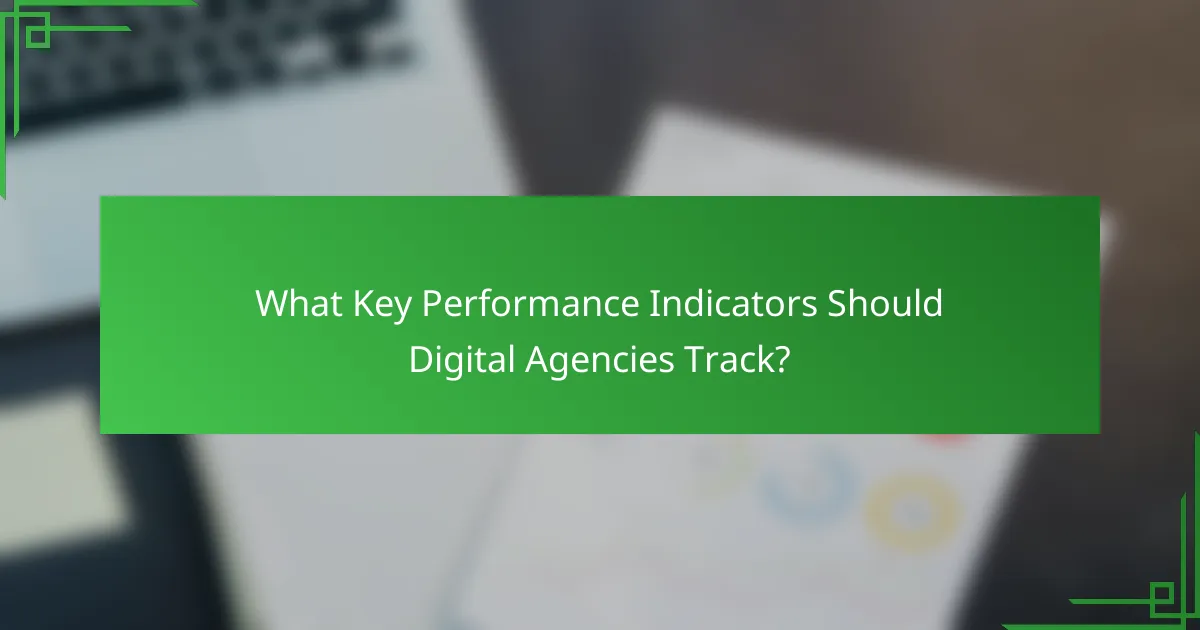In the competitive landscape of digital agencies, tracking key performance indicators (KPIs) is essential for measuring operational efficiency and driving growth. By focusing on metrics such as client acquisition cost, customer lifetime value, and revenue growth, agencies can gain valuable insights into their financial health and client satisfaction. These metrics not only inform strategic decision-making but also help ensure long-term sustainability in a rapidly evolving market.

What Key Performance Indicators Should Digital Agencies Track?
Digital agencies should track key performance indicators (KPIs) that reflect their operational efficiency, client satisfaction, and financial health. Focusing on metrics like client acquisition cost, customer lifetime value, and monthly recurring revenue can provide actionable insights for growth and sustainability.
Client Acquisition Cost
Client acquisition cost (CAC) measures the total cost of acquiring a new client, including marketing expenses, sales team salaries, and any other related costs. Understanding CAC helps agencies evaluate the efficiency of their marketing strategies and budget allocation.
A common rule of thumb is to aim for a CAC that is less than one-third of the customer’s lifetime value. For example, if a client generates $3,000 over their lifetime, the CAC should ideally be under $1,000. Regularly analyzing this metric can prevent overspending and ensure profitability.
Customer Lifetime Value
Customer lifetime value (CLV) estimates the total revenue a client will generate during their relationship with the agency. This metric is crucial for understanding how much to invest in acquiring new clients and retaining existing ones.
To calculate CLV, multiply the average purchase value by the average purchase frequency and the average customer lifespan. For instance, if a client spends $500 annually and stays for 5 years, the CLV would be $2,500. Monitoring CLV helps agencies tailor their services and marketing efforts to maximize client retention.
Return on Investment
Return on investment (ROI) measures the profitability of investments made in marketing, technology, or other areas. It is calculated by dividing the net profit from an investment by the cost of the investment, expressed as a percentage.
A positive ROI indicates that the investment is generating more revenue than it costs. Agencies should aim for an ROI of at least 20-30% on marketing campaigns. Regularly reviewing ROI can help identify which strategies are effective and which need adjustment.
Monthly Recurring Revenue
Monthly recurring revenue (MRR) is the predictable revenue that an agency expects to receive every month from subscriptions or ongoing contracts. MRR provides a clear view of financial stability and growth potential.
To calculate MRR, multiply the total number of active subscriptions by the average revenue per subscription. For example, if an agency has 100 clients paying $200 monthly, the MRR would be $20,000. Tracking MRR helps agencies forecast cash flow and plan for future investments.
Net Promoter Score
Net Promoter Score (NPS) gauges client satisfaction and loyalty by asking clients how likely they are to recommend the agency to others. This score ranges from -100 to 100 and is calculated based on responses to a simple survey question.
A high NPS indicates strong client loyalty, while a low score suggests areas for improvement. Agencies should aim for an NPS of 50 or higher. Regularly measuring NPS can help identify strengths and weaknesses in service delivery, guiding enhancements to client experience.

How Can Digital Agencies Measure Growth Effectively?
Digital agencies can measure growth effectively by tracking key performance indicators (KPIs) that reflect their financial health, client satisfaction, and online presence. Focusing on metrics such as revenue growth, client retention, and website traffic provides actionable insights for strategic decision-making.
Year-over-Year Revenue Growth
Year-over-year revenue growth is a critical metric that indicates how much a digital agency’s income has increased compared to the previous year. This growth can be influenced by factors such as new client acquisition, upselling services, or expanding into new markets.
To calculate this metric, subtract last year’s revenue from this year’s revenue, divide by last year’s revenue, and multiply by 100 to get a percentage. A healthy growth rate typically ranges from 10% to 30%, depending on the agency’s size and market conditions.
Agencies should regularly review their revenue growth to identify trends and adjust their strategies accordingly. Setting quarterly revenue targets can help maintain focus and drive performance.
Client Retention Rate
The client retention rate measures the percentage of clients that continue to work with an agency over a specific period. High retention rates indicate client satisfaction and loyalty, which are essential for sustainable growth.
To calculate this rate, take the number of clients at the end of a period, subtract new clients acquired during that period, and divide by the number of clients at the start of the period. A retention rate above 80% is generally considered strong in the digital agency sector.
Improving client retention can be achieved by enhancing communication, providing exceptional service, and regularly soliciting feedback. Agencies should focus on building long-term relationships rather than just completing projects.
Website Traffic Growth
Website traffic growth reflects the increase in visitors to a digital agency’s website over time. This metric is crucial as it indicates the effectiveness of marketing efforts and the agency’s visibility in the digital landscape.
Tracking website traffic can be done using tools like Google Analytics, which provides insights into user behavior, traffic sources, and engagement metrics. A consistent growth rate of 15% to 25% per year is a good benchmark for agencies aiming to expand their online presence.
To drive traffic growth, agencies should invest in search engine optimization (SEO), content marketing, and social media strategies. Regularly updating content and optimizing for mobile devices can also enhance user experience and attract more visitors.

What Metrics Indicate a Successful Digital Agency?
Successful digital agencies track several key metrics to gauge their performance and growth. These metrics provide insights into how well the agency is converting leads, managing projects, and utilizing its workforce.
Lead Conversion Rate
The lead conversion rate measures the percentage of potential clients who take a desired action, such as signing a contract or making a purchase. A high conversion rate indicates effective marketing and sales strategies, typically ranging from 2% to 10% depending on the industry and agency size.
To improve your lead conversion rate, focus on optimizing your sales funnel, enhancing your value proposition, and providing clear calls to action. Regularly analyze which channels yield the highest conversions and adjust your strategies accordingly.
Average Project Duration
Average project duration reflects the typical time taken to complete client projects. This metric helps agencies assess efficiency and resource allocation, with durations varying widely based on project complexity—ranging from a few weeks for simple tasks to several months for comprehensive campaigns.
Monitoring project duration can reveal bottlenecks in your workflow. Aim to establish benchmarks for different project types and regularly review timelines to identify areas for improvement, ensuring timely delivery and client satisfaction.
Employee Utilization Rate
The employee utilization rate indicates how effectively your team is working on billable tasks versus total available hours. A healthy utilization rate typically falls between 70% and 85%, balancing productivity with employee well-being.
To optimize this metric, track time spent on various tasks and encourage team members to focus on billable work. Be cautious of overloading employees, as this can lead to burnout and decreased quality of work. Regularly assess workloads and adjust as necessary to maintain a sustainable pace.

What Tools Can Help Track KPIs for Digital Agencies?
Several tools can effectively track KPIs for digital agencies, providing insights into performance and growth. Utilizing the right software can streamline data collection and analysis, helping agencies make informed decisions.
Google Analytics
Google Analytics is a powerful tool for tracking website performance and user behavior. It provides metrics such as page views, bounce rates, and conversion rates, allowing agencies to assess the effectiveness of their digital strategies.
To get started, set up goals that align with your business objectives, such as lead generation or sales. Regularly review your reports to identify trends and areas for improvement, ensuring you adapt your strategies accordingly.
HubSpot
HubSpot is an all-in-one marketing, sales, and service platform that offers robust KPI tracking capabilities. It allows agencies to monitor metrics related to customer engagement, lead nurturing, and sales performance.
Utilize HubSpot’s dashboard to visualize your KPIs in real-time. Focus on metrics like customer acquisition cost (CAC) and lifetime value (LTV) to gauge the effectiveness of your marketing efforts. Regularly update your strategies based on these insights to optimize growth.
Tableau
Tableau is a data visualization tool that helps agencies analyze and present their KPIs in an easily digestible format. It connects to various data sources, allowing for comprehensive analysis of performance metrics.
When using Tableau, create interactive dashboards that highlight key performance indicators relevant to your agency’s goals. This visual approach can facilitate better decision-making and communication with stakeholders. Ensure you regularly refresh your data for the most accurate insights.

What Are the Best Practices for Setting KPIs?
Best practices for setting Key Performance Indicators (KPIs) involve establishing clear, measurable objectives that align with your digital agency’s overall business goals. This ensures that your KPIs effectively track performance and drive growth.
Align KPIs with Business Goals
Aligning KPIs with business goals is crucial for ensuring that your agency’s efforts contribute to its success. Start by identifying your primary objectives, such as increasing revenue, improving client satisfaction, or enhancing brand awareness. Each KPI should directly reflect these goals.
For example, if your goal is to boost revenue, a relevant KPI might be the percentage increase in monthly sales or the average project value. Regularly review and adjust your KPIs to ensure they remain aligned with evolving business objectives.
Involve Team Members in KPI Selection
Involving team members in the KPI selection process fosters ownership and accountability. When employees participate in defining KPIs, they are more likely to understand their importance and strive to meet them. This collaborative approach can lead to more relevant and realistic KPIs.
Consider holding workshops or brainstorming sessions to gather input from various team members. This can help identify key metrics that reflect both individual and team performance, such as project completion rates or client feedback scores. Ensure that everyone understands how their contributions impact the overall success of the agency.

How Do Industry Benchmarks Impact KPI Selection?
Industry benchmarks play a crucial role in selecting key performance indicators (KPIs) by providing a reference point for evaluating performance. By comparing your agency’s metrics against established standards, you can identify areas for improvement and set realistic growth targets.
Understanding Industry Standards
Industry standards are established metrics that reflect the average performance of businesses within a specific sector. These benchmarks can include conversion rates, customer acquisition costs, and client retention rates. Understanding these standards helps digital agencies gauge their performance relative to peers.
For example, if the average customer acquisition cost in your sector is around $200, and your agency’s cost is significantly higher, it signals a need for strategic adjustments. Familiarizing yourself with these figures allows for more informed decision-making and goal-setting.
Comparative Analysis with Competitors
Conducting a comparative analysis with competitors involves evaluating your agency’s KPIs against those of similar businesses. This process can reveal strengths and weaknesses, helping to refine your strategies. Tools like benchmarking reports or industry surveys can provide valuable insights into competitor performance.
For instance, if your agency’s average project turnaround time is three weeks while competitors average two weeks, it may indicate inefficiencies in your processes. Regularly analyzing these comparisons can drive continuous improvement and foster a competitive edge in the market.

